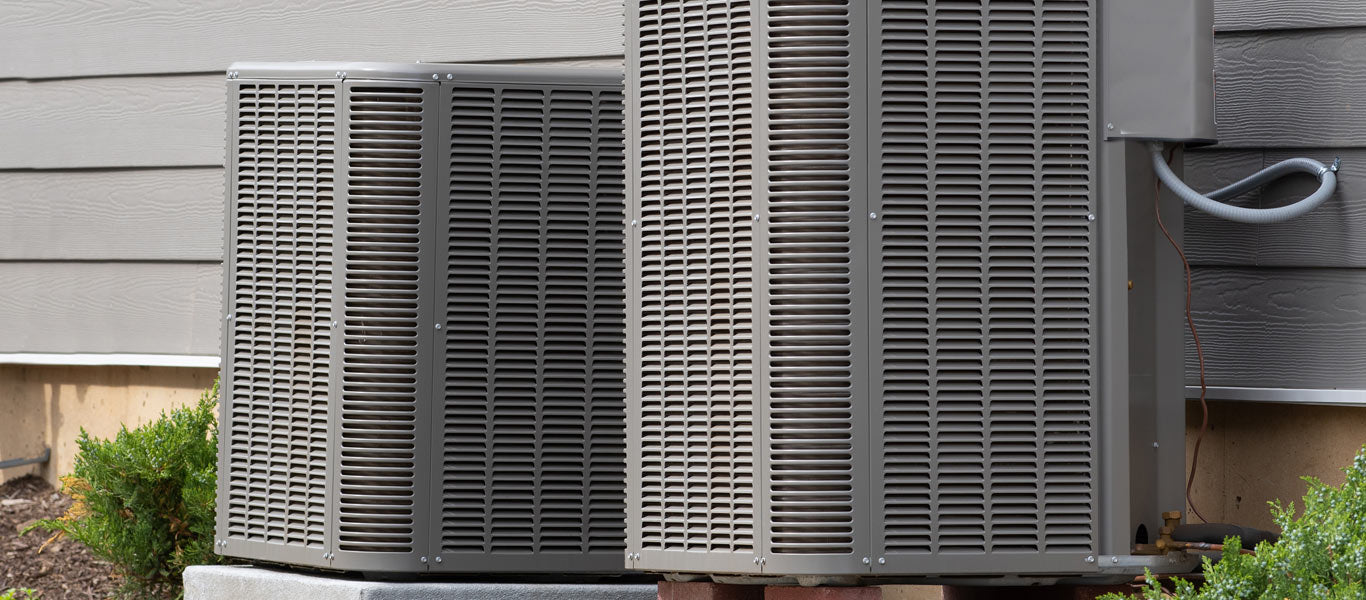Although there are various parts of an air conditioner, four main components keep your air conditioning unit operating like a well-oiled machine. They are the evaporator, condenser, compressor, and expansion valve. Each of these components functions in sync and has a specific job of providing cooling comfort for your home.

Discover Top-Grade Air Conditioners: View Our Products Today
The Most Important Parts of an Air Conditioner and Their Functions
The most important parts of an air conditioner are the evaporator coil, compressor, condenser coil, and expansion valve. Each component is part of a circuit connected by refrigerant tubing and plays a pivotal role in cooling your home. When one element ceases to function, the entire system goes down.
1. Evaporator Coil
The evaporator coil is attached to the furnace or contained within the air handler. The coil typically has an A-frame shape with two panels of thin, metal fins. The fins allow air to pass through to the refrigerant tubes. The tubing is made of heat-conductive metal such as copper, steel, or aluminum and bent into a series of U’s.
The evaporator coil’s role is to absorb heat and humidity from your home’s air. Cold refrigerant flows through the tubing while warm air from the house passes over the coil. The refrigerant absorbs the heat and humidity from the home’s air, and a fan blows the cooled air into the home through the vents. The warm refrigerant then flows outside to the compressor.
2. Compressor
The compressor is often referred to as the “heart” of the air conditioner because it pumps refrigerant through the air conditioning system. The compressor is located inside the condenser unit. The compressor receives the refrigerant after it has absorbed heat from the home’s air. At this point, the refrigerant is a warm, low-pressure vapor. The refrigerant will eventually circulate back inside the house to repeat the heat-removal cycle, but first, the refrigerant must be returned to a cold, liquid state.
The compressor performs the initial step in the cooling process. It applies energy until the refrigerant becomes a hot, high-pressure vapor. Using heat and pressure on the refrigerant serves two purposes. One, the refrigerant must be heated to a temperature higher than the outside air to release heat as it travels through the condenser’s coils. Two, pressurization allows the refrigerant to flow smoothly through the coils. After the compressor heats and pressurizes the refrigerant, it flows to the condenser.
3. Condenser Coil
The condenser coil releases heat the refrigerant has removed from the home’s air. The condenser is the central unit located outside the home. It resembles a box encased in thin metal fins. Beneath the fins, the surface of the condenser is covered in coils, usually made of copper.
The compressor releases hot, high-pressure refrigerant vapor into the condenser. The refrigerant moves through the condenser coils while the fan supplies cool air. The fan’s air cools the refrigerant in the coils, and the metal fins conduct heat away and into the outside air. The refrigerant condenses as it cools, becoming a liquid. The refrigerant flows to the expansion valve next.
4. Expansion Valve
The refrigerant enters the expansion valve after leaving the condenser coil. The valve reduces the refrigerant’s pressure, cooling it further. Once the refrigerant returns to a cold, liquid state, it can return to the evaporator coils to cool the home’s air and continue the cycle.
Other Air Conditioner Components
Your air conditioner contains other necessary components besides the four main parts. The air filter, refrigerant, fan, and thermostat are four more essential parts of the cooling system.
How does an air conditioner work?
An air conditioner’s various components remove heat and humidity from the air inside a home and release the heat outside. The refrigerant, evaporator and condenser coils, compressor, condenser, expansion valve, fans, air filter, and thermostat are essential in cooling a home’s air.
The main parts of the air conditioner exist in a circuit connected by tubes of flowing refrigerant. When the thermostat senses the temperature is higher than the temperature at which it’s set, it sends a signal to the compressor to begin the cooling cycle. Refrigerant is in a cold, liquid state when it flows through the evaporator coils. The refrigerant absorbs heat and humidity from the home’s air. The blower fan blows cold air throughout the home’s ducts and vents while the air filter filters out particles and contaminants. The refrigerant changes to a gas as it warms and is pumped out of the home to the compressor. The compressor increases the pressure and temperature of the refrigerant and pumps it through the condenser coils. The condenser fan helps release the refrigerant’s heat outside. The refrigerant flows through the expansion valve to reduce pressure and cool it further. Once the refrigerant turns back to a cold liquid, it flows back to the evaporator coils to repeat the cycle.

Discover Top-Grade Air Conditioners: View Our Products Today
Conclusion
All of the air conditioner’s components have a role in supplying clean, cold air to your home. The evaporator and condenser coils, the compressor, and the expansion valve are the four main components through which refrigerant flows, transferring heat from the inside to the outside. The fans help to move cold air through the home and release heat outside.
Homeowners must also be familiar with the thermostat and the air filter. The thermostat tells the air conditioner when to cycle on and off, but the homeowner must use the thermostat to turn on the air conditioner and set the desired temperature. The homeowner must change the air filter every 30-90 days for optimal performance.








3 comments
Aerovent
MD KAMAL HOSSAIN
Excellent thanks for your topics
Rick
This is an interesting article. I had heard that the air conditioner blows cold air instead of removing the heat.